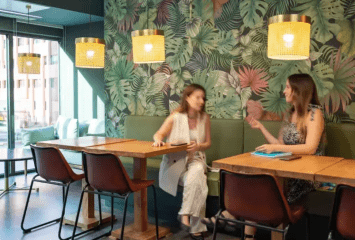Warm minimalism for offices
The minimalist trend entered a process of revaluation about a decade ago and, since then, many homes and workplaces have been designed based on its basic principles. However, for many people, this decorative style, so inspired by Nordic and Japanese traditions, is in a certain sense slightly cold. In response to this feeling, in the last five years a new and much more welcoming trend derived from minimalism has emerged, known as warm minimalism. One focused on combining lightness with friendliness. One that dominates the decorative trends for offices in this 2023. These are its properties:
The importance of color
One of the usual characteristics of classic minimalism is the sobriety of colors: white, gray and black often dominate the spaces with the intention of transmitting few stimuli and immerse the mind in a greater tranquility. However, as we pointed out before, some people find this monochromatism somewhat inert. Warm minimalism, on the other hand, uses a wider range of colors, including pastels, browns and pinks. The office continues to generate that feeling of lightness that so deeply favors concentration and well-being, but has more vivid tones that bring more humanity to the whole.
Light wood tones
Nordic environments, which drink directly from minimalism, usually have wooden furniture painted in white or black, in an attempt, again, to transmit few stimuli. Warm minimalism follows another path: it also chooses furniture strategically and tries not to include anything that is not strictly necessary, but those that it does include appear bare and made of very light woods. It is a way of providing the office with a connection to nature and thus satisfying the biophilic needs of workers, i.e. the desire to reconnect with life. In this sense, warm minimalism has a decidedly human-centric approach.
Combination of textures
Traditional minimalism seeks to reduce contrasts to a minimum in order to project homogeneity. Hence, offices decorated in this style feature only one, two or three different textures. Again, warm minimalism follows another path, namely the use of multiple different textures to give the office more affectivity. For example, a combination of different woods, wool, cotton, leather, velvet, stone or even cement. The idea is that the minimalist character is not so crude and that a middle ground between austerity and comfort is reached. In addition, in warm minimalism there is room for plants, capable of transforming offices.
Handcrafted elements
Handcrafted elements convey to people more feelings of warmth than industrial elements. After all, they have been made by other human beings with their own hands. They are a kind of bridge between them. That is precisely why warm minimalism makes use of them to round off workspaces. From handmade carpets to decorative figures, pictures of paintings or even furniture created by carpenters. In any case, it is important that such furniture maintains simple lines, which is a fundamental characteristic of warm minimalist furniture. No detailed shapes or filigree.
Light above all else
Few factors are as decisive in the warmth of an office as the amount of natural light that penetrates it. And it is not that conventional minimalism is oblivious to this issue. All decorative styles pay attention to light. However, in warm minimalism it is of paramount importance. After all, even a space of combined textures, handcrafted elements and warm-type colors can feel lifeless without a good light input. In addition, warm minimalist offices also include bulbs of an orange hue to maintain that warmth in the darker hours. Human well-being matters at any time of the day.

